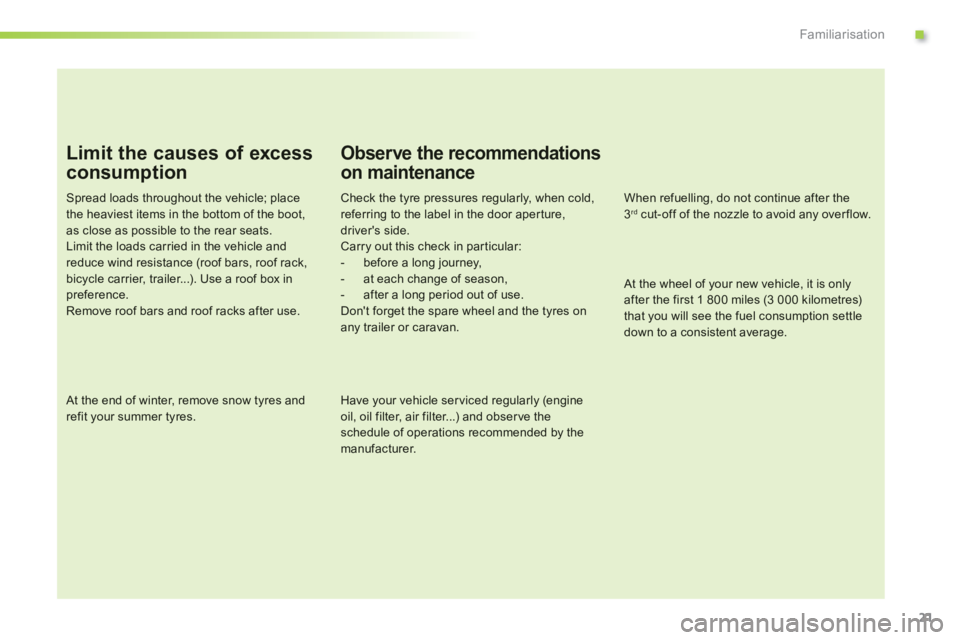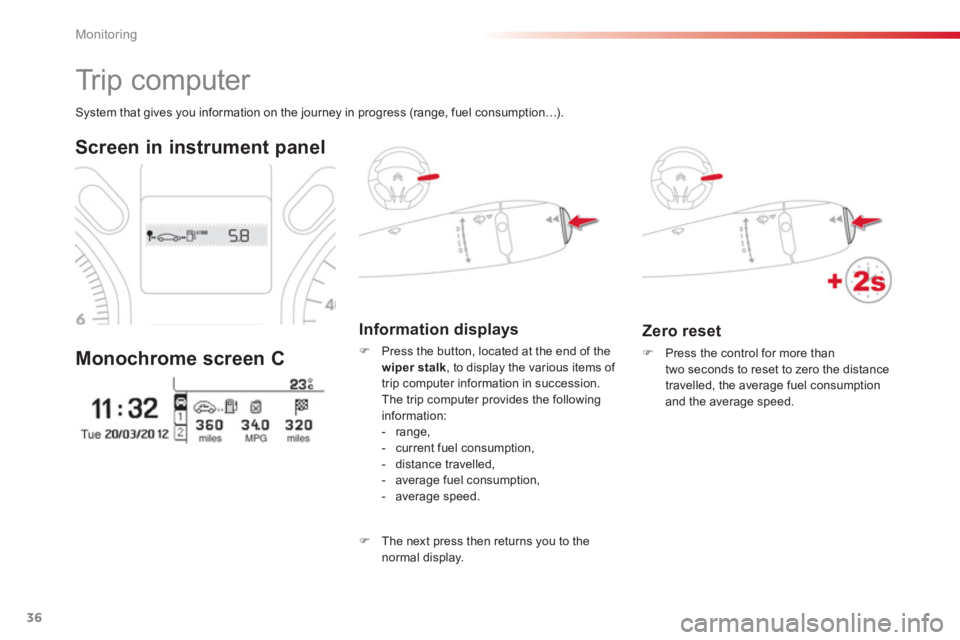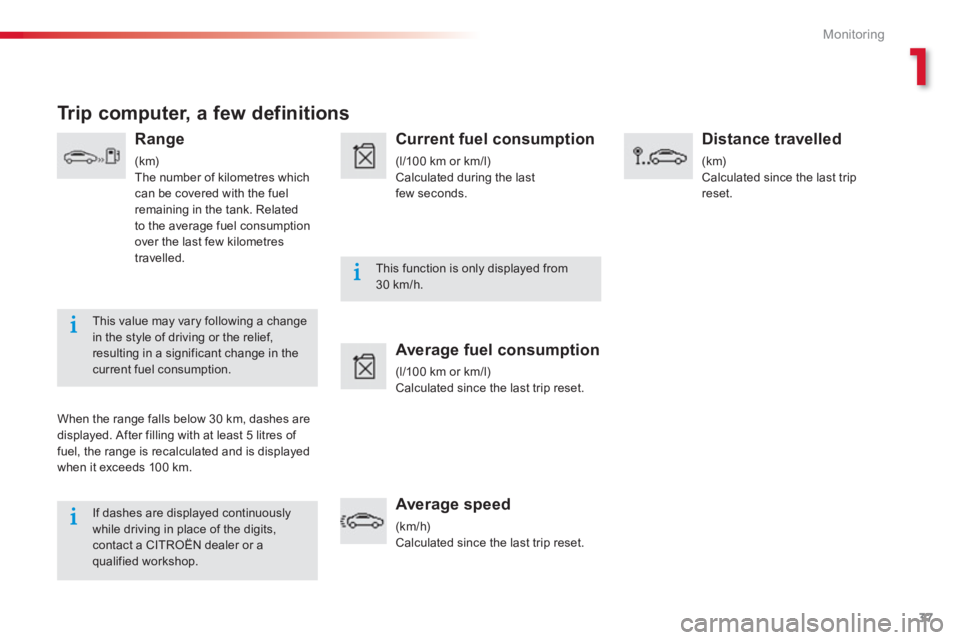fuel consumption CITROEN C-ELYSÉE 2014 Handbook (in English)
[x] Cancel search | Manufacturer: CITROEN, Model Year: 2014, Model line: C-ELYSÉE, Model: CITROEN C-ELYSÉE 2014Pages: 257, PDF Size: 9.06 MB
Page 22 of 257

20
Familiarisation
Eco-driving
Eco-driving is a range of everyday practices that allow the motorist to optimise their fuel consumption and CO2emissions.
Optimise the use of your
gearbox
With a manual gearbox, move off gently,change up without waiting and drive by changing up quite soon.
With an automatic or electronic gearbox, stay in Drive "D"or Auto "A"
, according to the type of gearbox, without pressing theaccelerator pedal heavily or suddenly.
Drive smoothly
Maintain a safe distance between vehicles, use engine braking rather than the brake pedal, and press the accelerator progressively. These practices contribute towards a reduction in fuel consumption and CO2 emissions and also helps reduce the background traffic noise.
If your vehicle has cruise control, make use of the system at speeds above 25 mph (40 km/h) when the traffic is flowing well.
Control the use of your
electrical equipment
Before moving off, if the passenger compartment is too warm, ventilate it byopening the windows and air vents before using the air conditioning.
Above 30 mph (50 km/h), close the windows and leave the air vents open.
Remember to make use of equipment that canhelp keep the temperature in the passenger compartment down (window blinds...).
Switch off the air conditioning as soon as the desired temperature is attained.
Switch off the demisting and defrostingcontrols, if not automatic. Switch off the heated seat as soon as possible.
Switch off the headlamps and foglamp whenthe level of light does not require their use.
Avoid running the engine before moving off,particularly in winter; your vehicle will warmup much faster while driving.
As a passenger, if you avoid connecting your multimedia devices (film, music, videogame...), you will contribute towards limitingthe consumption of electrical energy, and soof fuel.
Disconnect your por table devices beforeleaving the vehicle.
Page 23 of 257

.
21
Familiarisation
Limit the causes of excess
consumption
Spread loads throughout the vehicle; placethe heaviest items in the bottom of the boot,as close as possible to the rear seats.Limit the loads carried in the vehicle and reduce wind resistance (roof bars, roof rack, bicycle carrier, trailer...). Use a roof box inpreference.Remove roof bars and roof racks after use.
At the end of winter, remove snow tyres and refit your summer tyres.
Observe the recommendations
on maintenance
Check the tyre pressures regularly, when cold, referring to the label in the door aper ture, driver's side.Carry out this check in par ticular:- before a long journey,- at each change of season,- after a long period out of use. Don't forget the spare wheel and the tyres onany trailer or caravan.
Have your vehicle ser viced regularly (engine oil, oil filter, air filter...) and obser ve the
schedule of operations recommended by themanufacturer.
When refuelling, do not continue after the3 rd
cut-off of the nozzle to avoid any over flow.
At the wheel of your new vehicle, it is only after the first 1 800 miles (3 000 kilometres) that you will see the fuel consumption settledown to a consistent average.
Page 38 of 257

36
Monitoring
Zero reset
�)Press the control for more than
two seconds to reset to zero the distance
travelled, the average fuel consumption and the average speed.
System that gives you information on the journey in progress (range, fuel consumption…).
Tr i p c o m p u t e r
Screen in instrument panel
Monochrome screen C
Information displays
�)
Press the button, located at the end of the wiper stalk
, to display the various items of
trip computer information in succession.
The trip computer provides the following
information:
-
range,
- current fuel consumption,
- distance travelled,
- avera
ge fuel consumption,
- average speed.
�)
The next press then returns you to the
normal display.
Page 39 of 257

1
37
Monitoring
If dashes are displayed continuouslywhile driving in place of the digits, contact a CITROËN dealer or aqualified workshop.
This function is only displayed from 30 km/h.
This value may vary following a changein the style of driving or the relief,resulting in a significant change in thecurrent fuel consumption.
Tr ip computer, a few definitions
Range
(km)
The number of kilometres which can be covered with the fuel remaining in the tank. Related
to the average fuel consumption over the last few kilometres
travelled.
When the ran
ge falls below 30 km, dashes are
displayed. After filling with at least 5 litres of fuel, the range is recalculated and is displayed
when it exceeds 100 km.
Current fuel consumption
(l/100 km or km/l)
Calculated during the last few seconds.
Average fuel consumption
(l/100 km or km/l)
Calculated since the last trip reset.
Average speed
(km/h)
Calculated since the last trip reset.
Distance travelled
(km)
Calculated since the last tripreset.
Page 71 of 257

69
3
Comfort
Rear screen demist - defrost
The control button is located on the heating / ventilation or air conditioning system controlpanel.
Switching on
The rear screen demisting/defrosting can onlyoperate when the engine is running.�)Press this button to demist/defrost the rear screen and (depending on version) the door mirrors. The indicator lamp associated with
the button comes on.
Switching off
The demisting/defrosting switches off automatically to prevent an excessive consumption of current.�)
It is possible to stop the demisting/defrosting operation before it is switched
off automatically by pressing the button
again. The indicator lamp associated with
the button goes off. �)
Switch off the demisting/defrosting of the rear screen and door mirrors, if fitted,
as soon as appropriate, as lower currentconsumption results in reduced fuelconsumption.
Heated lower windscreen *
In cold conditions, the heated rear window switch also allows the lower windscreen to beheated, so as to free the wiper blades whenfrozen to the glass by frost or snow.
The function is active when the ambient temperature is below 0°C.
*
Depending on country of sale.
Page 82 of 257

80
Driving
Automated mode
AUTOand the gear engaged appear in the instrument panel.
Manual mode
The gears engaged appear insuccession in the instrument panel.
The
gearbox then operates in auto-adaptive mode, without any action on the par t of thedriver. It continuously selects the most suitable gear taking account of:
- optimisation of fuel consumption,
- driving style,
- road conditions,
- v
ehicle load.
For optimum acceleration, when over takinganother vehicle for example, press theaccelerator pedal fully down, beyond the point of resistance. The
gear change requests are only carried out
i
f the engine speed permits.
It is not necessary to release the accelerator
pedal during gear changes.
When braking or slowing down, the gearbox changes down automatically so that the vehicle
picks up in the right gear.
Under full acceleration, the change up will not
take place unless the driver operates the gear lever (unless the engine is close to its maximum
speed).
Never select neutral (position N ) when moving.
You can change mode at any time bymoving the gear lever from Ato Mor the other way round.
Never select neutral (position N) whenmoving.
You can change mode at any time by moving the gear lever from A
to M
or the other way round.
�)Select position A.�)
Select position M.
Reverse
To engage reverse, the vehicle must be
immobilised with
your foot on the brake.�)Select position R.
At low speed, if reverse gear is requested, the Nwarning lamp flashes and the gearbox goes
into neutral automatically.
To e n
gage reverse, put the gear lever intoposition N, then to position R
.
There is an audible signal onengagement of reverse.
Page 86 of 257

84
Driving
Manual operation
�)Select position M for sequentialchanging
o
f the four gears.�)Push the lever towards the + sign tochange up a gear. �)Pull the lever towards the -
sign to change
down a gear.
It is only possible to change from one gear to another if the vehicle speed and engine speedpermit; otherwise, the gearbox will operate
temporarily in automatic mode.
D disappears and the gears engaged appear in succession in the
instrument panel.
Invalid value during manual operation
This symbol is displayed if a gear
is not engaged correctly (selector
between two positions).
Stopping the vehicle
Before switching off the engine, you can engage
position Por N
to place the gearbox in neutral.
In both cases, apply the parking brake to
immobilise the vehicle.
Operating fault
When the ignition is on, the
lighting of this warning lamp,
accompanied by an audible signal and amessage in the multifunction screen, indicates
a gearbox fault.
In this case, the gearbox switches to back-up mode and is locked in 3rd gear. You may feel
a substantial knock when changing from Pto Rand from N to R
. This will not cause any damage to the gearbox.
Do not exceed 60 mph (10 0 km/h), local speed
restrictions permitting.
Contact a CITROËN dealer or a qualified
workshop as soon as possible.
I
f the engine speed is too low or too high, the
gear selected flashes for a few seconds, then
the actual gear engaged is displayed.
It is possible to change from position D(automatic) to position M (manual) at any time.
When the vehicle is stationary or movingvery slowly, the gearbox selects gear M1automatically. The spor t and snow programmes do not
operate in manual mode.
There is a risk of damage to thegearbox:
- if you press the accelerator and brake pedals at the same time,
- if you force the movement of the gear lever from the Pposition toanother position when the battery isflat.
To reduce fuel consumption when at
a prolonged standstill with the enginerunning (traffic jam...), put the gear lever in the Nposition and apply the parkingbrake.
If the lever is not in position P
, when the Pdriver's door is opened or approximately 45 seconds after the ignition is switchedoff, a warning message appears in the screen.�)Return the lever to position P; the message disappears.
Page 175 of 257

173
11
Technical data
Identifi cation markings
A.Vehicle identification number (VIN)under the bonnet.
This number is engraved on the bodyworknear the passenger compartment filter.
The tyre pressures must be checked when the tyres are cold, at least oncea month.
Low tyre pressures introduces the riskof a burst tyre and also increase fuel consumption.
B.Vehicle identification number on thedashboard. This number is indicated on a self-adhesive label which is visible through the
windscreen.
C.Manufacturer's label.The VIN is indicated on a self-destroying
label affixed to the lower right hand centre
pillar.
D.Tyre/paint label.This label is affixed to the driver's side centre pillar. It bears the
following information:
- the tyre pressures, for unladen and laden
conditions,
- the tyre sizes,
- the spare t
yre inflation pressure,
- the paint colour code.
Various visible markin
gs for the identification of your vehicle.
Page 230 of 257

228
Alphabetical index
Filling with fuel ..........................................52-54Fitting a wheel...............................................131Fitting roof bars.............................................157Fittings, boot...................................................73Flashing indicators ........................100,134, 137Front foglamps ........................................93, 136Front seats......................................................55Fuel............................................................20,54Fuel consumption............................................20Fuel f iller cap...................................................52Fuel filler flap...................................................52Fuel gauge..........................................15, 3 0, 52Fuel tank....................................................52, 53Fusebox, dashboard.....................................141Fuses .............................................................139
Gearbox, automatic ........................82, 146,167Gearbox, electronic.........................78, 146,167Gearbox, manual....................................77,167Gear lever, automatic gearbox .......................82Gear lever, electronic gearbox ..........................78Gear lever, manual gearbox...........................77Glove box........................................................71
Halogen headlamps......................................133Hands-free kit................................................189Hazard warning lamps ..................................100Headlamps..............................................91, 133Head restraints, front......................................56Heated lower windscreen ...............................69Heating..........................................14, 20, 63, 65Height adjustment, steering wheel .................60Horn...............................................................100
Keeping children safe....................105, 11 0 -119Key in ignition warning....................................75Key with remote control ............................ 42-45
Labels, identification ..................................... 173Lamps, front..................................................133Lamps, warning and indicator...................r23-31Level, brake fluid ........................................... 164
Levels and checks.................................160-165Lighting............................................................91Lighting, guide-me home ................................95Lighting, interior..............................................r99Lighting bulbs (replacement).................133-138Lighting control stalk.......................................91Lighting on reminder.......................................r94Loading....................................................20,157Load reduction mode.................................... 146Locating your vehicle......................................43Lower windscreen defrosting..........................69
Jack...............................................................126JACK socket ....................................72, 187, 215
F
GJ
H
K
L
Electronic engine immobiliser...................r43,45Emergency boot release.................................50Emergency braking system ..........................101Emergency starting.......................................145Emergency warning lamps...........................100Energy economy mode .................................147Engine, Diesel .................54,161,162,170, 171Engine, petrol..................................54,160, 168Engine compartment .............................160,161Engine compar tment fusebox.......................143Engine oil......................................................163Engine oil dipstick .........................................163Engines .................................................168,170Environment................20,45, 62, 146, 165, 173ESP/ASR.......................................................102
Ignition.............................................................75Indicators, direction ......................100,134, 137Inflating accessories (using the kit) ..............125Inflating tyres..................................20, 125, 173
Inputs for audio system ...................72,187, 215Instrument panel.............................................22Instrument panel screen.................................22Interior fittings ...........................................70-72ISOFIX child seats .................................117,118ISOFIX mountings.........................................116
I
Page 239 of 257

4
Driving
Gear shift indicator
System which reduces fuel consumption by advising the driver to change up.
On vehicle fitted with a manual gearbox, the arrow is accompanied by the gear recommended.
With an electronic or automatic gearbox, the system is only active in manual mode.
The system adapts its gear change recommendation according to the driving conditions (slope, load, ...) and the demands of the driver (power, acceleration, braking, ...).
The system never suggests: - engaging first gear, - engaging reverse gear, - engaging a lower gear.
Operation
Depending on the driving situation and your vehicle's equipment, the system may advise you to skip one (or more) gear(s). You can follow this instruction without engaging the intermediate gears. The gear engagement recommendations must not be considered compulsory. In fact, the configuration of the road, the amount of traffic and safety remain determining factors when choosing the best gear. Therefore, the driver remains responsible for deciding whether or not to follow the advice given by the system. This function cannot be deactivated.
Example: - You are in third gear. - You press the accelerator pedal. - The system may suggest that you engage a higher gear.
The information appears in the instrument
panel in the form of an arrow.